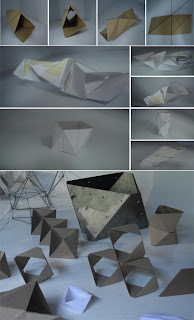On Feb 01st the students presented the results of the first exercise, Material Exploration: Theory and Practice. Organized in groups, the students looked at a material chosen from a selection of 5: Timber, Concrete, Plastic, Fiber and Steel. Each material was then studied by two groups of students, one per Design Unit. During the preceding 3 weeks students collected what we called “theoretical” information on their material: History, Technical aspects, Structural Behavior, industrial processes of formation/transformation of the material, Corrosive/Ageing/Damaging agents, available formats, local suppliers, prices etc. At the same time “practical” operations where performed on their material in order to understand “first hand” its qualities, opportunities and restrictions: pleating, folding, weaving, cutting, pilling, hinging, punching, etc.
 Equipo Concreto Seccion 01: V. Trabucco, C. Fragachan, N. Gonzalez,
Equipo Concreto Seccion 01: V. Trabucco, C. Fragachan, N. Gonzalez, Equipo Concreto Seccion 02: C. Chicchirichi, M. Jimenez, K. Gascon,
Equipo Concreto Seccion 02: C. Chicchirichi, M. Jimenez, K. Gascon,
I. Piscitelli, D. Schniderman, S. Soriano, Y. Suarez.
 Equipo Plastico Seccion 01: A. Acevedo, L. Bassano, M. Calatrava,
Equipo Plastico Seccion 01: A. Acevedo, L. Bassano, M. Calatrava,  Equipo Plastico Seccion 02: A. Castillo, D. Hernandez, Y. Pedroza,
Equipo Plastico Seccion 02: A. Castillo, D. Hernandez, Y. Pedroza, Plastic: in an attempt to give more structural stability to a corrugated PCV panel, students developed a system which unfolds the potential for its use as light shading device/dividing panel. Similar results were achieved by understanding the inherent structural logics of PCV tubes while the same format produced a prototype which unfolds the potential for a structural system to emerge.

En el estudio del acero ambos equipos, luego de explorar en maquetas las posibilidades del material en sus distintos formatos (perfiles, laminas, tubos), se decantaron por el acero laminar con el cual proponen, en un caso una pieza modular que, según su articulación con otros módulos , permite construir una superficie con propiedades autoportantes. En otro caso, un modulo base, cuyo diseño toma como oportunidad la restricción en el numero máximo de plegaduras que permite una maquina dobladora, ofrece también la posibilidad de construir una superficie autoportante. En ambos casos las piezas pueden, según su tamaño final de construcción, actuar como filtro de luz o generar espacios susceptibles de ser habitados entre otras posibilidades.
 Equipo Acero Seccion 02: Y. Bautista, S. Camaton, E. fernandez,
Equipo Acero Seccion 02: Y. Bautista, S. Camaton, E. fernandez,
G. Hernandez, M. Gonzalez, M. Zorrilla.
Steel: After a brief testing of some operations in paper and cardboard models, both teams opted for laminated steel as its preferred format. In one case a pleated piece of steel, when articulated with similar ones, produces a self-bearing module, which also unveils spatial opportunities. In another one, the restriction on the number of pleats a machine can manage on a single steel sheet allowed the students to produce a modular piece, which when combined at different scales could behave as light controlling device or offer spatial inhabitation opportunities.
 Equipo Fibra Seccion 01: A. Chacon, A. De Lima, D. Pozo,
Equipo Fibra Seccion 01: A. Chacon, A. De Lima, D. Pozo,
Y. Gonzalez, G. Petit, R. Salcedo.
El estudio de técnicas de cestería tradicional indígena en un caso y de puntos de tejido en el otro permitió a los equipos que estudian la fibra construir piezas que revelan su potencial tanto de ser usada como superficies como de actuar como sistemas constructivos en si mismo , esto es, cuando se combinan las resistencias estructurales de distintos tipo s de fibra. Los resultados en ambos casos permitieron a los estudiantes confirmar de manera directa que la fibra es un material que estructuralmente responde mejor a esfuerzos de tensión.

Fiber: weaving traditional techniques from local indigenous groups were tested by one team, producing prototypes for surface construction. Depending on the orientation of the fiber, its humidity level and the weaving sequence, the surface acquires different geometrical results. Another group looked at knitting techniques which allowed them to understand and work within the structural properties (forces of tension and bending) of the fiber when combined in different types (bamboo, jute, etc)
 Equipo Madera Seccion 01: J. Flores, A. Fuentes, K. Montero,
Equipo Madera Seccion 01: J. Flores, A. Fuentes, K. Montero,
L. Palmero, G. Sosa, V. Valladares.
En la madera los estudiantes entendieron que el éxito en la utilización de este material constructivo esta en la resolución del problema de la unión o junta como elemento de continuidad y estabilidad estructural. Así un grupo centro su atención en el estudio de las juntas de la construcción tradicional japonesa profundizando el entendimiento del mismo a través de la construcción de piezas 1:1. Otro grupo diversifico su atención en el estudio de distintas uniones: por amarre y por traba.
Timber: whilst one team looked at traditional Japanese construction techniques working with 1:1 models, another one looked at different types of joints in timber: knotted, halved joint, bridle joint, mortice and tenon joint, etc). Both teams were given first hand experience of what working with timber entails plus drew students closer to the end habitable scale.

Equipo Madera Seccion 02: P. Alvarez, A. Delgado, S. Garcia,
V. Leon, J. Torres, A. Salgado.
The diverse realm of results achieved offer an endless number of possibilities of construction: a catalogue of material opportunities which, like taxonomy, offer a detailed description of the spatial/structural potentials of such results. Students will have the opportunity of evaluate such possibilities while working on their own proposals for a habitable space which will be built at the end of this term.


